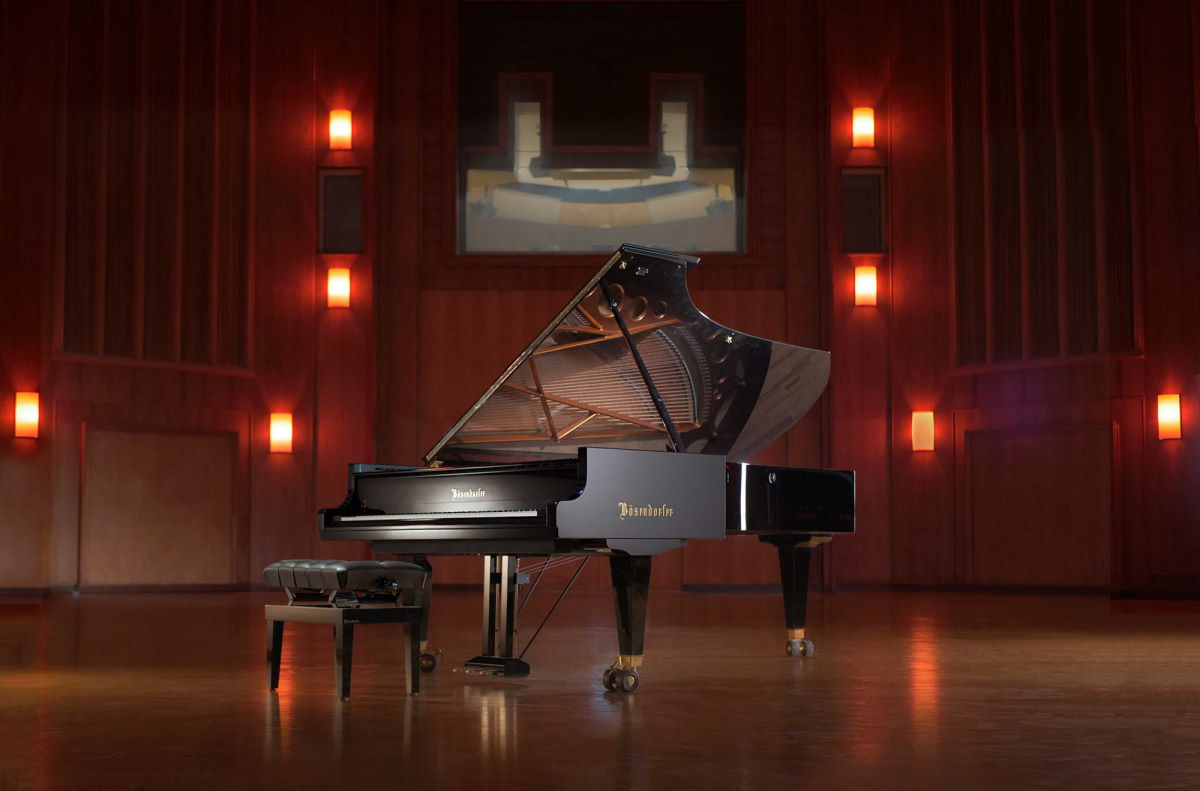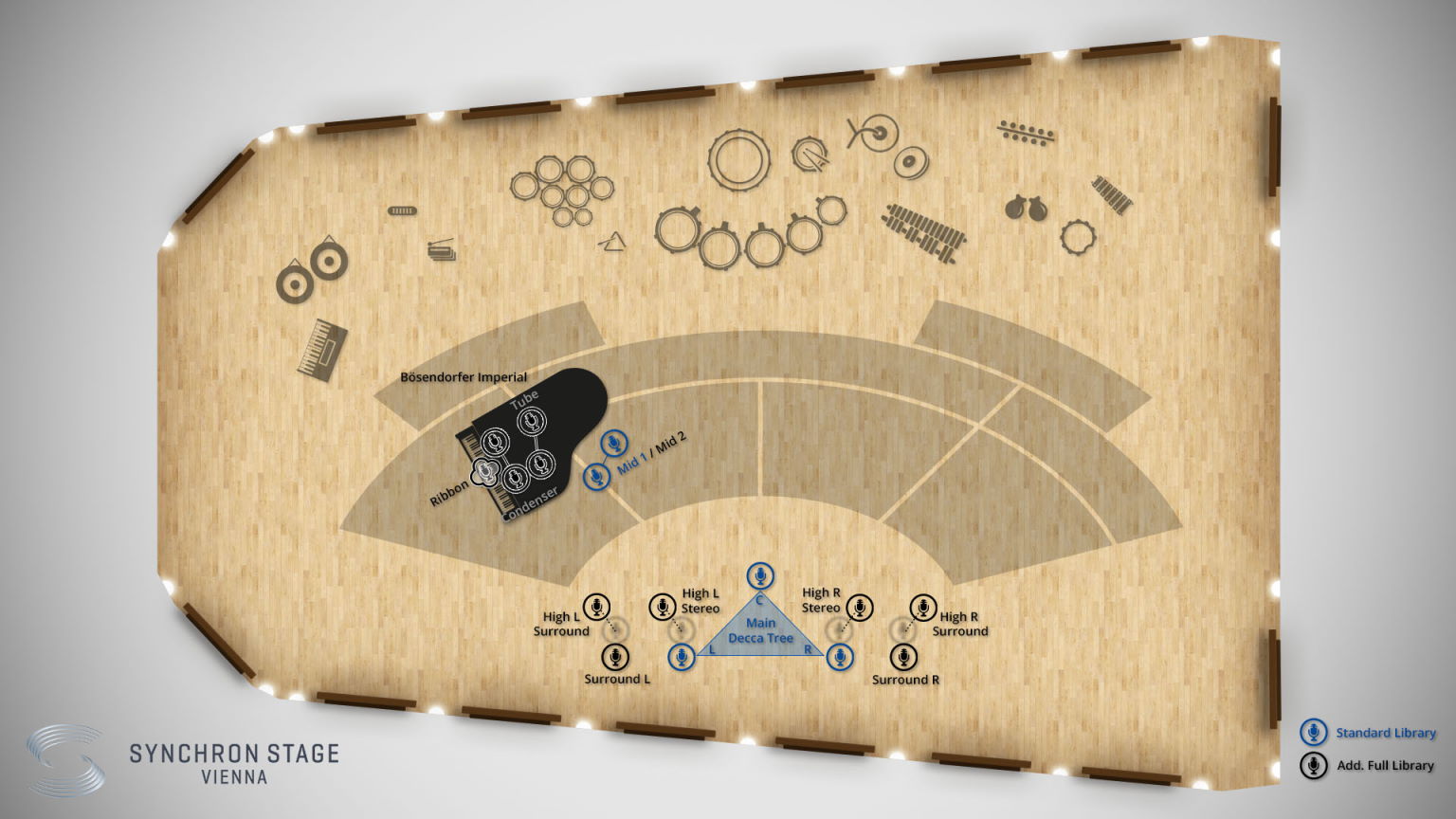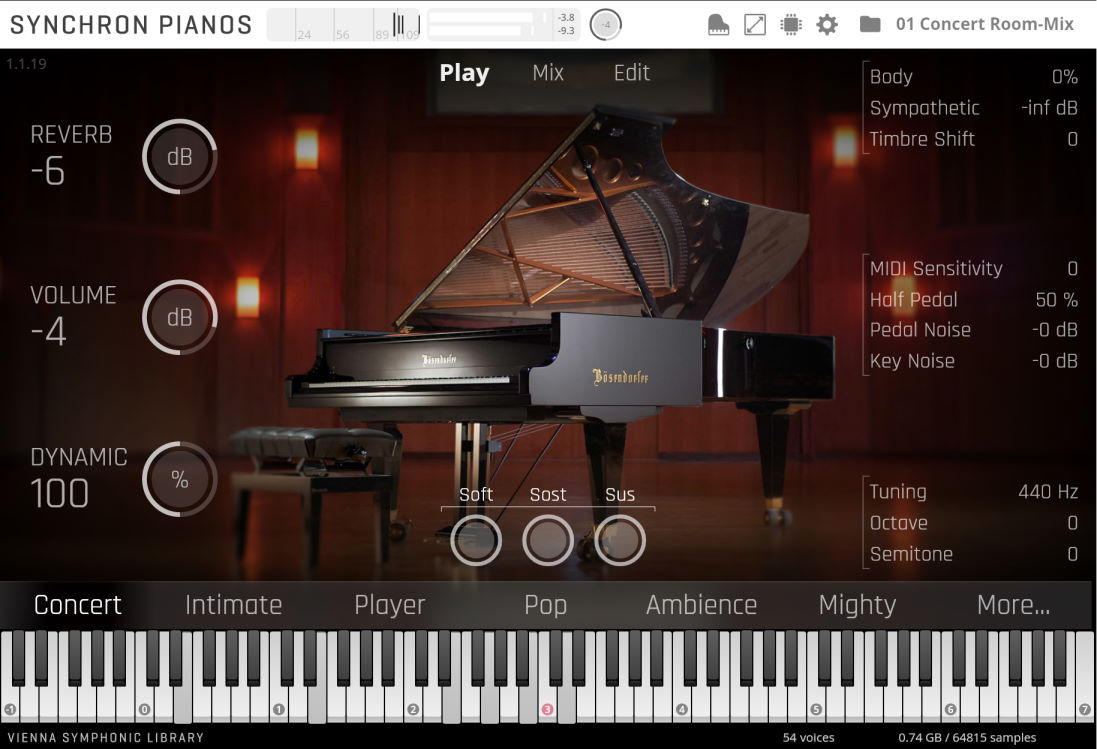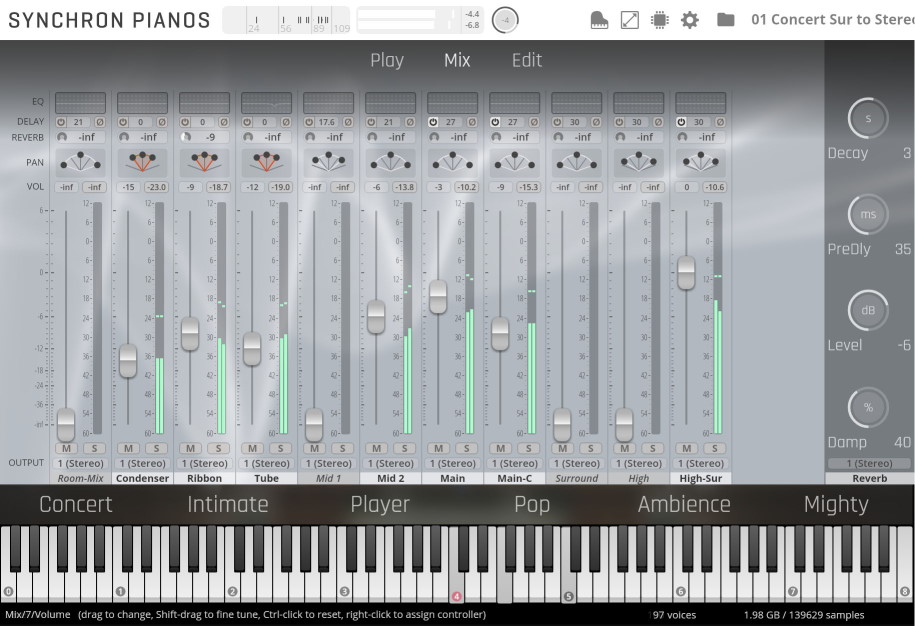Bösendorfer Imperial
Introduction
The Bösendorfer Concert Grand 290 Imperial represents the apex of the famed Austrian piano manufacturer's precious heritage. Its nine additional sub-bass notes extend the instrument's key range downward to the low C - for a total range of eight octaves. The extra bass strings create additional harmonic resonance with every key you strike, providing warmth, richness and depth across the entire instrument. The massive soundboard projects an unusually broad frequency range, evoking a sonorous, orchestral timbre.

We're always striving to improve and optimize our products and procedures - a special challenge, having set a very high bar with the grands we've previously captured at Synchron Stage Vienna. Listening back to the virtual representation of our brand-new Bösendorfer Imperial, we believe we've created a new milestone in the art of piano sampling.
What's more, our proprietary Release Sample Technology was even further refined, allowing the Synchron Player to automatically match hundreds of individual and finely stepped release samples per key to your played notes in real-time. The result is a hyper-realistic playing feel and 100% timbral authenticity.
As with all the instruments of our Synchron Pianos series, this Bösendorfer 290 Imperial enjoys permanent, climate-controlled residency at Synchron Stage Vienna, whose main hall is characterized by its particularly warm and natural ambience. The 540 m2 Stage A has lent its acoustic signature to numerous international productions, from classical chamber music to international, large-scale orchestral film scores.
Standard and Extended Library
The instrument was recorded using 10 microphone positions. The Standard Library includes 4 of these sections, allowing you to integrate instruments recorded with a stereo Decca tree into your projects using our new Synchron Player software. Adding the Extended Library and thus getting the Full Library expands your possibilities to 5.1 surround and Auro 3D 9.1.
Microphone positions
With over 4,000 samples per key and almost 20,000 samples per microphone position, the Bösendorfer Imperial boasts breathtaking authenticity. In order to capture this marvelous instrument in one of the best acoustic environments on the planet, our recording engineers used multiple high-end microphone arrays, affording an abundance of options for creating your individual sound.

Standard Library
- Room Mic (Mix)
- The Room Mix channel contains a stereo mix of all available room microphones from the Full Library
- Condenser - Close 1 (Sennheiser MKH 8040)
- "ORTF" setup with a pair of Sennheiser MKH 8040, positioned as closely as possible over the hammer area. Ideal for producing the typical "pop piano" sound.
- Mid 1 (Sennheiser MKH 800)
- "ORTF" setup with a pair of Sennheiser MKH 800 mics for a wide, warm yet bright and centered sound.
- Main/Room Mic
- Decca Tree array (L-C-R) with three DPA 4006 mics. These very neutral microphones captured even the smallest detail of Synchron Stage Vienna. Used in a stereo mix, you can easily hear where the piano is placed. In a surround setup, the Decca tree microphones will be the feed for your front L-R speakers.
- Main/Room Mic - Decca Tree Mono (Center)
Extended Library
Even if you're not using a surround setup, you get more ambience variation and spatial depth out of the Full Library by adding the room microphones' signals to your stereo mix.
- Ribbon - Close 2 (Royer SF-24)
- "Blumlein" setup with two ribbon figure-eight capsules of a Royer SF-24 mic, for a fast, direct, and natural sound.
- Tube - Close 3 (Neumann M149)
- "ORTF" setup of a Neumann M-149 stereo pair, capturing the beauty of the Steinway D with the analog warmth and richness only a legendary tube microphone can provide.
- Mid 2 (Sennheiser MKH 8040)
- "ORTF" setup with a pair of Sennheiser MKH 8040 mics for a centered, but harder and more focused sound than the MID 1 Position.
- Main Surround - Stereo (L/R)
- Wide A-B stereo setup with two DPA4011 cardioid microphones. You may use them as so-called "Wides" or "Outriggers" in a stereo mix in order to create an even more spacious impression. In a surround setup, these microphones would be used for your rear speakers.
- High Stereo (3D) - Stereo (L/R)
- Stereo A-B-setup with two AKG C-414 condenser microphones, spotting the very nice reflections of Synchron Stage Vienna's ceiling. In stereo mixes, you can use them as an alternative to your main mics, or you may down-mix these much more diffused signals. The sound is more "sparkling" and reverberant compared to the main mics. Used in an Auro 3D or Dolby Atmos mix, these microphones should feed your top or ceiling speakers.
- High Surround (3D) - Stereo (L/R)
- Like the High Stereo (3D) setup, this A-B array features two AKG C-414 microphones.
The instrument Presets also include different mixer presets. By default the classic room mixes are loaded which include the Standard Library microphone positions. These are balanced in the stereo field to represent the respective instrument's position in the Synchron Stage set-up.
Immersive Sound and Auro 3D
Auro 3D is an immersive audio technology that allows for three-dimensional sound perception. The Belgian company Auro Technologies developed this technology based on a special speaker configuration, adding four additional speakers to a 5.1 surround configuration. These speakers (so-called "Heights'') are situated above the front and surround speakers and generate acoustic reflections that are perceived naturally due to the fact that sounds originate from around as well as from above the listener. Thanks to the comprehensive selection of discrete audio channels with the Full Library of Synchron Percussion I you may mix your instruments in Auro 3D as well as in Dolby Atmos.
About Pitch
For designating pitch, the Vienna Symphonic Library uses International Pitch Notation (IPN), which was agreed upon internationally under the auspices of the Acoustical Society of America. In this system the international standard of A=440 Hz is called A4 and middle C is C4. All pitches are written as capital letters, their respective octave being indicated by a number next to it. The lowest C on the piano is C1 (the A below that is A0), etc.
Walkthrough Videos
About this piano
The Imperial's magically unfolding tonal character, especially apparent in the pianissimo to mezzoforte range, was meticulously sampled in finely calibrated velocity steps using our proprietary piano robot that we've further developed and perfected. To guarantee a consistent sound over all keys, velocities and note lengths, the total recording production time was scheduled as tightly as possible to minimize even the smallest changes in the instrument's sonic behavior. A sufficient block of time was reserved at the Synchron Stage, but after recording nearly 24 hours a day it still took several weeks to capture the 290 Imperial in its entirety.
Key Features
- Bösendorfer Imperial
- Full 8 octaves in tonal range - 97 keys (with bass extension)
- Warm, orchestral sound, rich in depth and tone color
- Powerful bass
- Over 4,000 samples per key for maximum authenticity, liveliness, and feel.
- Recorded in the natural ambience of one of the best recording halls in the world, Synchron Stage Vienna
- Utmost realism, capturing all of the instrument's nuances with our proprietary precision sampling technology
- Hyper-realistic playing feel
- Multiple microphone positions - for a multitude of timbral variations
- Intuitive, customized Synchron Pianos software with high-performance playback engine
- Six pre-configured presets: "Concert", "Intimate", "Player", "Pop", "Ambience", "Mighty"
- Soft (una corda), sostenuto, sustain pedals
- Half-pedalling and re-pedalling
- Sympathetic resonance
- Body resonance
- Dedicated release samples, depending on played release velocity
- Detailed pedal sounds for soft and sustain pedals, depending on pedal speed

Advanced Release Sample Technology
To capture the Bösendorfer Imperial with all its subtleties, our engineers developed a highly precise motion-control system based on a solenoid that controls a noise-free "robot finger". The micro-controller moves the finger with super-human precision, providing flexible curvatures for down-strokes and release movements. The MIDI controlled system delivers more than 100 velocities and various release samples, depending on the preceding note length and various release speeds.
This innovation represents the pinnacle of our long-term sampling robotics development. An earlier version of the robot finger was used for sampling the Celeste found in our Synchron Percussion I Collection.
Customize Your Personal Sound
In addition to the multitude of options from mixing various microphone signals, the Synchron Concert D comes with our free Vienna Synchron Pianos Software that offers multiple options for shaping your sound and the playing experience. Hosting a high-performance playback engine, the software provides a musician-friendly user interface that allows for quick and easy timbral control. Create your sound intuitively by filtering particular key ranges or even single keys, adjust the body resonance of the instrument or add just a pinch of algorithmic reverb to refine the overall sound.

Included Presets
In the browser window of the Synchron Pianos player you may select from four general preset categories
Room Mix (Standard Library)
Ready-made, resource saving presets with as few microphones as possible. The "Room Mix" Channel contains a mix of all available microphones from the Full Library.
Decca Tree Multi Mic (Standard Library)
The classic sound of a Decca tree stereo recording features a more slender sound with less diffusion compared to the "Room Mix" Presets.
Surround to Stereo Downmix (Full Library)
These presets include all available room microphones with various runtime delays, creating more diversity in the perception of room depth.
Surround (Full Library)
Designed to send the microphone signals to your available surround channels.
Character Presets
The Synchron Pianos player interface offers instant and direct access to seven pre-configured character presets.
1. Concert
- Character: A grand spatial representation of the Bösendorfer Imperial at Synchron Stage Vienna.
- Perspective: Conductor, Piano on the left.
- Recommendation: Piano concerts
2. Intimate
- Character: Close sound with a soft touch of the room. Dampened high frequencies in mixer and reverb.
- Perspective: Player, centered
- Recommendation: For intimate ballads and low, mighty chords.
3. Player
- Character: Natural, close sound without any additional EQing and a soft touch of the room. Immediate response with the full stereo width of the keyboard and a natural response from the hall.
- Perspective: Player, centered
- Recommendation: Ideal recording preset
4. Pop
- Character: Powerful and assertive. Accentuated low and high frequencies with a short reverb.
- Perspective: Player, centered
- Recommendation: For live performances and in a band context.
5. Ambience
- Character: A spacious sound with a lot of reverb on all microphones.
- Perspective: Conductor, piano on the left.
- Recommendation: For film scores, soaring piano melodies and a powerful piano sound in the background.
6. Mighty
- Character: Echoing piano with a distinctive slapback created by the delay times on the microphones.
- Perspective: Conductor, piano on the left.
- Recommendation: Great for scenes with concrete walls, wide fields or industry halls. Adjust the runtime delay to your project tempo.
7. Concert Centered
- Character: Modified Concert Mix with the piano in the center of the mix.
- Perspective: Conductor, centered.
- Recommendation: Ideal for solo performances.